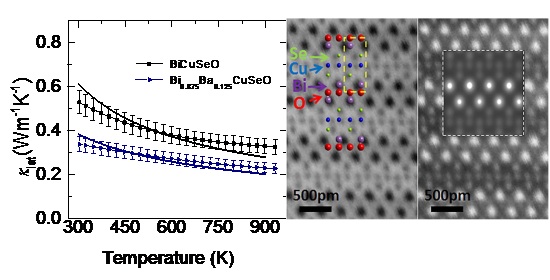Recently, the research groups of Prof. Jiaqing He from Physics Department at SUSTech published research paper entitled “Investigation into the Extremely Low Thermal Conductivity in Ba heavily doped BiCuSeO” on Nano Energy Online.
Thermoelectric power generation is a promising technology to relax world-wide energy crisis by directly converting waste heat into electrical power. Among all those thermoelectric materials, thermally stable oxides, especially these consisting of nontoxic and naturally abundant elements are regarded as promising candidates for high temperature TE power generation. Heavily doped Bi0.875Ba0.125CuSeO alloys were found to exhibit the highest ever ZT value in oxygenous thermoelectric systems, attributed to the extremely low thermal conductivity.

In this report, researchers investigated the microstructural reason of the thermal conductivity in Ba- heavily doped BiCuSeO through scanning transmission electron microscopy (STEM). Combined with DFT calculations and Callaway’s model simulation, they demonstrated unambiguously that the introduced Ba partially dissolves in the BiCuSeO matrix through occupying Bi lattices in (Bi2O2)2+ layers. When Ba amount exceeds its solubility limit, the redundant part will form BaSeO3 precipitates of varied scale. The Ba-Bi point defects scatter high frequency heat-carrying phonons and the precipitates are in charge of low and mediate frequency phonon scattering. These microstructures result in strong impedance of phonon transport and therefore large reduction in the lattice thermal conductivity.
The spherical aberration-corrected transmission electron microscopy observation results provide visual evidence of Ba substituting Bi atoms in Bi-O layers for the first time. Combined with the intrinsic layered structure and lattice vibration anharmonicity in BiCuSeO, Bi0.875Ba0.125CuSeO achieved high thermoelectric performance attributed to the extremely low thermal conductivity. These findings may shed light on further study of oxide-based thermoelectric materials.
Proofread By
Photo By